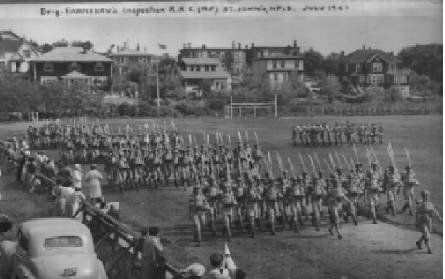(français ci-dessous) ↧
Joining The Royal Rifles of Canada
The Royal Rifles of Canada were in Sussex, New Brunswick and were about to be assigned to Coastal Defence duty in Gander, Newfoundland. Even that was better than what Infantryman Babin was doing. Royal Rifles recruiters were everywhere signing up all the men they could find to bring the Regiment up to strength. Babin was in Aldershot, Nova Scotia, at the time and wanting action decided to transfer from the Carleton & York to the Royal Rifles of Canada. He was taken on the Royal Rifles Roll in October of 1940 just before they were to leave for duties in Gander, Newfoundland. Babin went from Aldershot to Halifax and there boarded a ship to cross the Straits of Canso to Cornerbrook, Newfoundland and then on to Gander to join up with his new Regiment.
When Babin joined the Royal Rifles he found out that the Commanding Officer of the Regiment was "keen to have a Regimental Band". Always interested in music Babin was one of those who liked the idea.
Babin: When we were in Gander the Royal Rifles wanted to form a band. They were anxious to form a band ... so I joined up."
It was a crucial decision.
"When I joined the Royal Rifles I became a Rifleman, but when I became a Bandsman I was attached to Battalion Headquarters and worked in the Medical Section as a stretcher-bearer."
At that time Bandsmen became stretcher-bearers in time of war.
And so it was that Babin, one of the few men truly qualified as an infantryman, became a non-combatant. The man, one of the few, that had proper weapons training could not carry a weapon of any kind.
"I was already trained as an Infantryman. I had gone through all the training but when I went to Hong Kong I never did any of that kind of duty."
Babin would never fire a shot in anger. His job was to save lives, not take them. His only protection was a narrow band of white cloth around his upper arm with a red cross on it. Not much of a defence against an enemy bent on killing anything in its path that moved.
Devenu membre des Royal Rifles of Canada
Les Royal Rifles of Canada était à Sussex, au Nouveau-Brunswick, et étaient sur le point d'être affectés à la défense côtière à Gander, Terre-Neuve. Même cela était préférable à ce que faisait le fantassin Babin. Les recruteurs des Royal Rifles allaient partout enrôler tous les hommes qu'ils pouvaient trouver pour amener le régiment à son plein rendement. Babin était à Aldershot en Nouvelle-Écosse à ce moment et, désirant participer à l'action, a décidé de se faire transférer du Carleton & York aux Royals Rifles of Canada. Ces derniers l'ont accueilli formellement en octobre 1940, juste avant de partir pour Gander, Terre-Neuve. Babin est parti d'Aldershot pour Halifax et, une fois rendu, a pris un navire à travers les détroits de Canso jusqu'à Corner Brook, Terre-Neuve, puis à Gander pour retrouver son nouveau régiment
Lorsque Babin a rejoint les Royal Rifles, il a découvert que le commandant du régiment voulait un orchestre. Babin, qui s'était toujours intéressé à la musique, était un de ceux qui aimait l'idée.
Babin: Lorsque nous étions à Gander, les Royal Rifles voulaient partir un orchestre. Ils étaient impatients de le faire... je me suis donc porté volontaire.
C'était là une décision cruciale.
« Lorsque j'ai adhéré aux Royal Rifles je suis devenu carabinier, mais lorsque je suis devenu membre de l'orchestre, je relevais du poste de commandement du bataillon et j'ai travaillé pour le service médical à titre de brancardier. »
À cette époque, les membres d'orchestre devenaient brancardiers en temps de guerre.
Et donc Babin, un des seuls hommes à se qualifier réellement comme fantassin, est devenu non-combattant. Un des quelques hommes à avoir reçu une formation adéquate en maniement des armes ne pouvait en porter d'aucune façon.
« J'étais déjà formé comme fantassin. J'avais suivi toute la formation mais lorsque j'ai été envoyé à Hong Kong je n'ai jamais exercé ces fonctions. »
Babin ne tirerait jamais une balle sous le coup de la colère. Sa mission était de sauver les vies et non de les détruire. La seule protection dont il jouissait était une bande étroite d'étoffe blanche qu'il portait autour du bras supérieur, dotée d'une croix rouge. Ce n'était pas grand défense contre un ennemi qui s'était donné comme objectif de tout tuer ce qui bougeait sur son passage.

"D" Company, Royal Rifles of Canada and the Royal Rifles Band in the background
La Compagnie « D », les Royal Rifles of Canada et la Royal Rifles Band
en arrière-plan